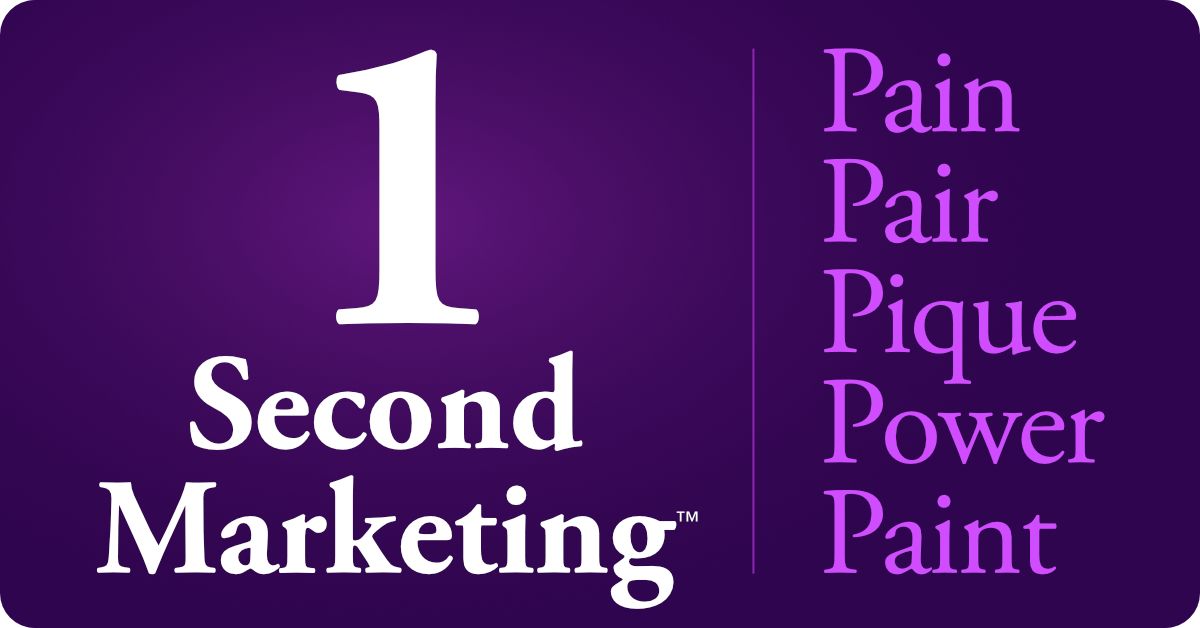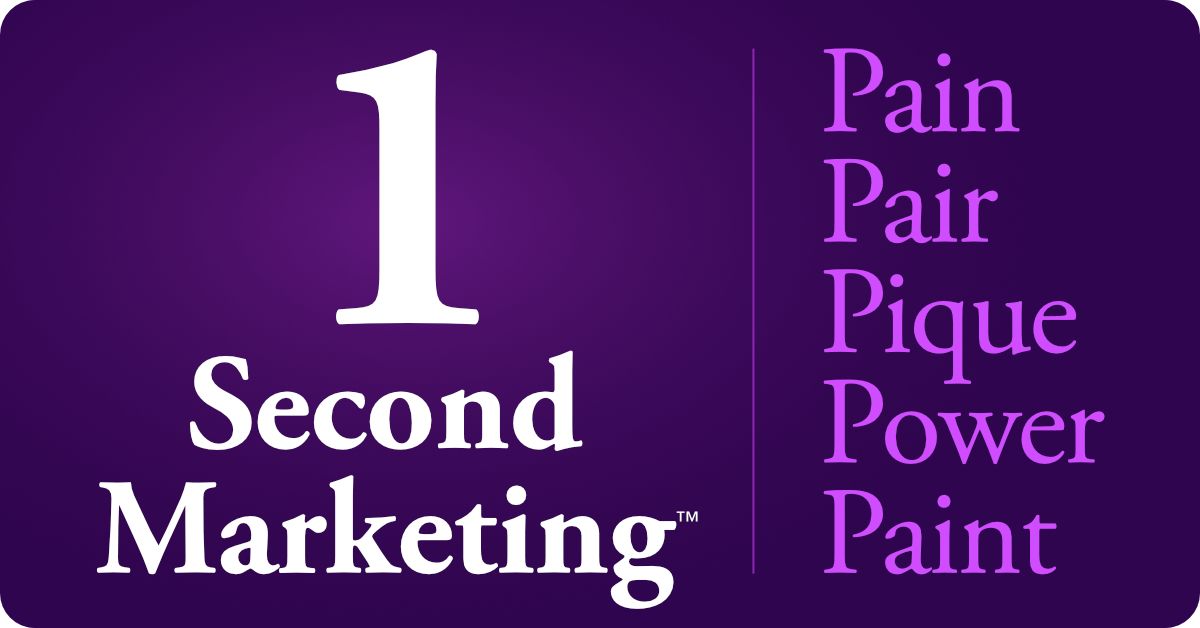The 4 P's of Marketing are Obsolete. Meet the 1 Second Marketing Framework™.
The 4 Ps of Marketing are obsolete. It's time for a new marketing framework for a short attention span digital world.

Do we really need another marketing framework? I say yes. Most of the central theories and practice of marketing still in use today were developed decades ago, long before the internet, mobile apps, and social media. For example, the 4 P's of marketing (product, price, place, promotion) were established in the 1950's and expanded upon as the "Marketing Mix" by Harvard professor Neil Borden. The concept of "Positioning" was introduced by Al Ries and Jack Trout in a series of articles in Advertising Age in 1972.
Take the example of "Place". Imagine a retail store on Main street. It has a clear place. But what if that store also has an e-commerce operation? Where is that company's "place" if they can now sell nationally or even globally?
These well worn principles as originally intended no longer fit our current market reality. So what are we doing instead? We've forgone the essential components of marketing, and rushed headlong into the shiny new thing -- digital marketing. We now have things like "growth hacking" and "performance marketing" which are disciplines that are more technical than art. Indeed a "performance marketer" need not be trained as a marketer at all. Research the keywords, build your landing pages, nurture your funnel, and click by click draw the customer to a close. This approach is clearly working to the tune of billions of dollars (maybe more for the big tech companies that enable it than the advertisers) but in the frenzy of this activity, a tremendous amount of marketing dollars are wasted.
Proxima (Bain) research shows that 40-60% of digital marketing dollars are essentially wasted. And this WSJ article says at least 23% of the $88 billion spent annually by marketers on digital marketing is wasted.
In the rush to play with the shiny new digital marketing thing, many companies are skipping over what I would argue is a more centrally important marketing activity, which is to get their company or product first impression right in a short attention span world. We are in such a hurry to get out there and promote, that we've neglected to get our own house in order so that it's ready when visitors arrive. Have you ever visited a website that you thought might be useful and found it hard to understand exactly what they do? I'm not just talking about poor UI, I'm talking about a basic failure to clearly explain what they're offering, and how it might meet your needs.
Jumping to social, content, influencer, inbound, or search marketing without having this in place only breaks the funnel at its most critical juncture, the moment after your potential customer has clicked the ad and has now landed on your website or landing page. This make or break moment is where the customer can do one of two things: 1) learn more or 2) leave.
Within this shifting market environment and wasted effort, I introduce the idea of a new marketing framework, updated for a short attention span digital age. I call it the 1 Second Marketing™ framework, because it helps you get your marketing right in the first second that a customer is exposed to your company or product. It can be applied to home pages, landing pages, mobile app profiles in the app store, social ads, verbal elevator pitches, and sales presentations. It helps get your marketing house in order, so when guests arrive, they are intrigued enough to want to stay.
My hypothesis is that if marketing teams and even non-marketers can get this new framework dialed in, it can prevent a lot of wasted budgets and staff time on "spray and pray" marketing. Conversion rates should improve. Time spent on site will improve. Bounce rates will decrease. Funnel drop outs will decrease.
And as a training tool for marketing employees, the 1 Second Marketing™ Framework can inform development of sales tools, pitch decks, talking points, copy, and elevator speeches. It can shorten sales cycles, and reduce the need for extra meetings, emails, and calls just to explain what exactly it is that you do. It can guide marketing efforts to target the right customers with the right messages.
I've purposefully designed this framework to be simple, so even non-marketers can understand it. It will require some homework, brainstorming, and strategic thinking to execute, but at least it will give your team a structure and sequential process to follow.
Here's the framework:

Let's walk through these 1 at a time:
- Pain Point: What is your customer’s #1 pain point? Many marketing efforts begin with the product, its features and benefits, etc. But this is an error. It fundamentally gets us off on the wrong foot. We quickly get lost in our product's bells and whistles, whether customers care about them or not. Instead, the 1 Second Marketing™ framework starts with the customer. From their perspective, we can market more effectively because we're centering the rest of the framework activities around the customer's needs.
- Pair Solution: Now that you've identified your customer's major pain, how exactly does your solution "pair up" to alleviate that pain? Here we are looking for a "pain match", a direct, head-to-head alignment between the pain point and your solution. If you cannot answer this step in the framework, you are headed for the dreaded "product/market fit" problem, where you might be building something that no one actually needs.
- Pique Interest: Now that we know how our solution addresses the customer pain, what specific solution angle will pique their interest? Any given product has multiple features, benefits, and value props. In this section we are narrowing to the sharpest possible, most intriguing angle that directly targets the customer's #1 pain. No customer can read 7 headlines all at once, so we have to be brutally restrictive here, and select our single best marketing attribute to focus on.
- Power Phrase: This is where we start to get practical. Put your copywriting hat on, because we are now going to craft a single phrase that uses our chosen "Pique" attribute, and form it into a catchy and compelling statement. This will be the #1 headline on your brochure, website, landing page, etc. It's the first thing customers will read, so this phrase is a cornerstone of your first impression marketing effort.
- Paint Picture: Now that your customer has read your Power Phrase, and hopefully found it compelling, they will begin scanning for additional information to further confirm that what you have to offer will meet their need. In this final phase, we will paint the rest of the picture. What exactly are we painting? I intentionally use a visual metaphor here, because a picture is worth 1000 words. Before just dropping in your bullet list of features, is there a way to visually convey your solution in support of the Power Phrase? This could be a photo, diagram, screenshot, video, or illustration. You are now painting a picture of the ideal situation -- you want your customer to visualize how their life will be better if they're using your solution.
If you can get these 5 framework elements dialed in, it forms the basis for so many other marketing efforts. The Pain Point reminds all employees of the real-world problem your product solves, and your very reason for existing. The Paired Solution ensures that you're aiming for product/market fit. The Piqued Interest helps prioritize your messaging. The Power Phrase can be applied to ads, the title slide on your sales PPT, your social media bio, and more. The Painted Picture can be used as a recurring branded visual theme throughout your marketing materials.
These 5 essential elements from the foundation of your marketing efforts, and from there you can now chase the shiny new digital marketing thing, knowing exactly who you're trying to reach, what pain you're trying to solve for, why customers should stay to learn more, and why you're the best solution for their needs. And hopefully you'll spend less time and money "spraying and praying" across the digital wasteland.
We're living in a short attention span digital world. It's time for a new framework.
Did you find this interesting? Make sure you don't miss future editions by signing up for my email newsletter, where I'll be elaborating on the framework and sharing some real world examples of how it can be applied.
And please consider forwarding this to a friend, or posting on your social media, your followers might find this helpful too!
See you on the next edition!
-Dave
